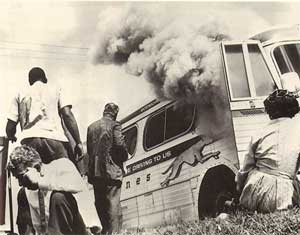Fifty years later
A tribute to anti-racist Freedom Rides
By
Abayomi Azikiwe
Editor, Pan-African News Wire
Published May 19, 2011 10:12 PM
|
Firebombing of Freedom Ride bus,
May 14, 1961, Anniston, Ala.
|
May 4 was the 50th anniversary of the beginning of the Freedom Rides, a major
civil rights campaign that legally broke the back of racial segregation in
interstate public travel in the United States. “Freedom Riders,” a
powerful documentary directed by Stanley Nelson, aired on PBS on May 16 and
sparked much discussion on both the historical significance of the Civil Rights
movement as well as the current status of African Americans today.
The documentary featured interviews and archival news footage of the period in
1961 when anyone, Black or white, challenging segregation in the South risked
imprisonment, torture and even death. During the course of the lunch counter
sit-ins the previous year in 1960, a broad-based student movement was formed
and organized by the Student Nonviolent Coordinating Committee.
The Freedom Rides were started by the Congress of Racial Equality, a
nonviolent, civil rights organization founded in 1942. On May 14, 1961, a
Freedom Ride Greyhound bus was firebombed in Anniston, Ala. The Freedom Riders
were then savagely attacked with lead pipes and baseball bats by a racist white
mob.
Resisting pressure from the Kennedy administration to abandon the Freedom
Rides, SNCC activists based in Nashville, Tenn., under the leadership of Diane
Nash, announced that it was essential that the Freedom Rides continue. The
documentary exposes the fact that President John Kennedy and his brother, then
U.S. Attorney General Robert Kennedy, were more interested in protecting the
image of the U.S. — which appeared increasingly racist — than in
supporting the Civil Rights movement, including the Freedom Rides.
Student activist Lucretia Collins summed up the sentiments within SNCC when she
said, “In Nashville, we had been informed that CORE was going to have
Freedom Rides that could carry people all over the South, and their purpose was
to test the facilities at the bus stations in the major cities. Later we heard
that a busload of the Freedom Riders had been burned on Mother’s Day in
Anniston, Ala., and that another bus had been attacked by people in
Birmingham.” (“The Making of Black Revolutionaries,” James
Forman, 1972)
Collins went on to stress that “CORE was discontinuing the Freedom Rides,
people said. We felt that it had to continue even if we had to do it ourselves.
We knew we were subject to being killed. This did not matter to us. There was
so much at stake, we could not allow segregationists to stop us. We had to
continue that Freedom Ride even if we were killed in the process.”
After the continuation of the Freedom Rides by SNCC and their supporters, the
federal government was forced to intervene by pressuring the Interstate
Commerce Commission to repeal the segregation laws that regulated interstate
public transportation. This was only done after hundreds of activists
volunteered to be imprisoned on false charges in Parchman Correctional Facility
in Mississippi, one of the most notorious prisons in the South. Although many
were beaten and tortured in Parchman, racist repression only fueled this heroic
mass, anti-racist movement.
Changing the course of history
The Freedom Rides, as the sit-ins had done the year before, provided greater
momentum for the Civil Rights movement. Increased mass mobilizations took place
throughout the South beginning in Albany, Ga., in 1962, when an
anti-segregation campaign brought out thousands for mass protests and
arrests.
In 1963, the Civil Rights movement would advance even further with mass
mobilizations in Birmingham involving thousands of students. These
demonstrations against segregation would spread throughout the South as well as
the North, to cities such as Somerville, Tenn., and Chicago.
These demonstrations during the spring and summer of 1963 led to the first
massive protests of the era, in Detroit on June 23 and later the historic March
on Washington, D.C., of 250,000 on August 28. The Civil Rights Act of 1964 was
then passed outlawing racial discrimination inside the U.S.
After the efforts of the Freedom Summer of 1964 in Mississippi and other areas
and the voting rights campaign in Selma during early 1965, the Voting Rights
Act of 1965 was passed ostensibly guaranteeing universal suffrage. In 1966, the
movement would become more militant when SNCC came out in opposition to the
draft and the Vietnam War as well as raising the slogan of Black Power during
the “March Against Fear” from Memphis, Tenn., to Jackson, Miss., in
June of that year.
Just as it took courage and creativity to break down legalized segregation in
the U.S., it will take greater efforts to defeat the ruling class’s
challenges placed before the people in the current period. Consequently, a
broad alliance of the workers and oppressed must come together to take on the
austerity measures and repression that are the latest mechanisms designed to
further the exploitation and oppression of the majority of people in the
U.S.
Go to www.pbs.org to view or for more information about the
documentary.
Articles copyright 1995-2012 Workers World.
Verbatim copying and distribution of this entire article is permitted in any medium without royalty provided this notice is preserved.
Workers World, 55 W. 17 St., NY, NY 10011
Email:
[email protected]
Subscribe
[email protected]
Support independent news
DONATE


